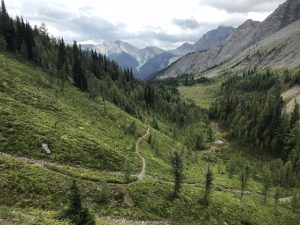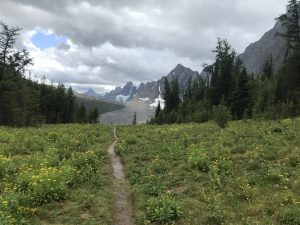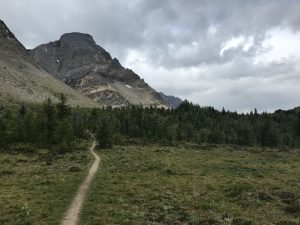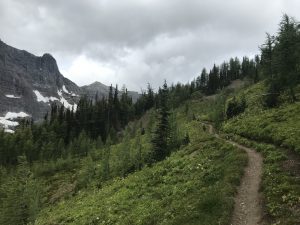Four years in the making. Two COVID cancellations and one stupid back injury, sustained while changing winter tires, kept me from toeing the line in Blairmore, Alberta to tackle what since has become an official Skyrace, part of an international circuit of races where the young and extremely fit battle it out on predominantly vertical and technical terrain. But now I’m here, the night before the race, doing a shake-out walk around Sparwood. Not a run, a walk. Another nagging injury kept me from running for the last ten days. The mood is gloomy, the legs feel heavy, and motivation is at an all time low.
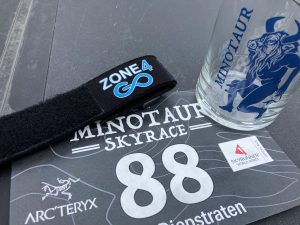
The advantage of my despondent attitude is that I’m not nervous. I fill my running vest with food and gear without much emotion, and I even sleep moderately well. We leave the hotel a few minutes late, and pull into Tim Hortons for a bathroom break with 7 minutes to go till the start of the mandatory pre-race meeting. Turns out we’re not the only ones slightly behind schedule, as we see racers walk and jog towards the starting area while the safety talk is already sounding from the speakers.

I meet a few people I know from the weekly training runs put on by Joanna. As much as there is wrong with social media, it still is a great, low-threshold way to meet people; good for a socially awkward introvert like me. Then it’s “ten – nine – eight” and we’re off. The ab injury nags, I sulk, and the fast crowd zips by towards the first pinch point in the race, going under the highway bridge. There will be many more pinch points on the narrow single track up Bluff Mountain. I look back and figure perhaps fifty racers are behind me. Probably two hundred ahead of me therefore.
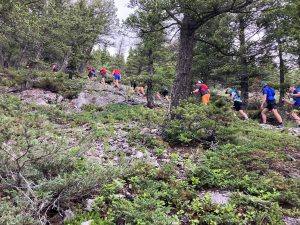
The climb is steep and direct, slowly the conga line starts to break, and I allow myself to commiserate a little longer as I contemplate the pace. As the terrain gets rockier, some racers start to take their time negotiating perceived difficulties, creating a harmonica wave of people: bunch up behind the slowest, stretch out when the terrain is easier. Despite my best efforts to take things in stride, it gets to me. With a few mumbled “sorry, do you mind if I pass” comments, I manage to create some breathing space, and I connect with a loose group of racers whose pace is just challenging enough to leave no room for griping. It’s go time.
A quick high-five marks the rounded summit of Bluff Mountain and before there is time to celebrate we’re on the steep soft downhill through the trees, trying to moderate the pace. An hour and half to the top, ahead of any conceived schedule. Briefly Prefontaine’s quote floats up from the pool of possible emotions: “There is only one pace, that’s suicide pace, and today feels like a good day to die.” Cockiness that will come to harm me.
I meet my daughter and overly excited dog near the first aid station. It’s a claustrophobic affair, with trees and ground vegetation, and too many people. A few pieces of bananas, cup of electrolyte and a water refill, and I leave it all behind, my dog barking in frustration that he is disallowed to join me. If next year there is a rule that dogs cannot be present in the aid station area, it’s probably our fault.
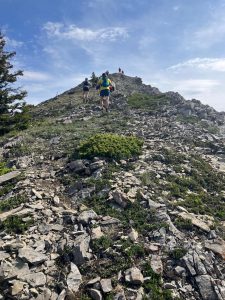
Not long into the second climb, the leg cramps start. Perhaps I am paying for the fast descent, even though it hadn’t felt too hard. Brief visions of DNF flash before me. Salt, water, food, shaking out the legs, trying to move differently, it helps a bit. I pass a few people. The false summits are disheartening, and the cramps return. More salt, keep drinking, and finally we crest and turn towards the infamous Shoe Shredder descent. It turns out to be not more difficult than what we have done in preparation.
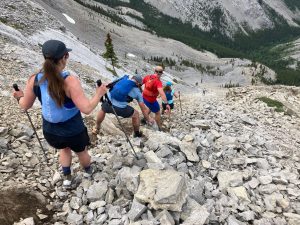
Not much longer I stumble into the second aid station. My daughter is there again with Finn, who has become even more agitated. Luckily nobody appears to be too annoyed with him, or they are just being polite. I down a few cups of electrolyte, eat some salty chips, break out the poles, and head out for the dreaded third climb.
Cramps continue to reoccur early in the ascent, and I try to focus on keeping my heels down, engaging the glutes. The cramps disappear, but the damage is done. Muscles stay sore. The trail up the avalanche chute is steep, endless, and I love it. Head down, find a rhythm, grind, just don’t stop. Soon the terrain changes, gets technical, a few no-trip ridges. The diversity of the terrain helps take my mind of the quads, it’s gorgeous up here. The third peak comes into view, way the hell out there. Left at the purple rock, down, around up, down, balance, jog a little, climb some more, enjoy the views. Even a sprinkle of rain.
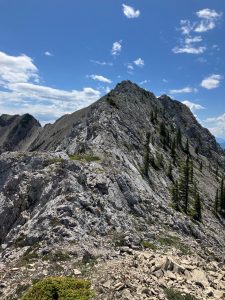
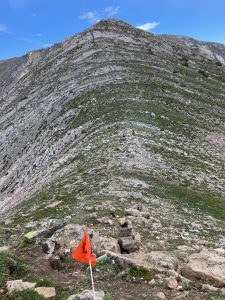 The long way down hurts. The trail becomes lonely, nobody is catching up, and I’m not catching anyone. Legs are empty. Focus wanders, and I trip. On a soft trail, very lucky. Checking the watch, I realize that a sub-nine hour finish is in reach, much better than the pre-race doom had allowed for. The descent seems never-ending, I’m glad for the poles that take some pressure of the legs. A few people pass me, I’m having trouble keeping a good pace on anything steep downhill.
The long way down hurts. The trail becomes lonely, nobody is catching up, and I’m not catching anyone. Legs are empty. Focus wanders, and I trip. On a soft trail, very lucky. Checking the watch, I realize that a sub-nine hour finish is in reach, much better than the pre-race doom had allowed for. The descent seems never-ending, I’m glad for the poles that take some pressure of the legs. A few people pass me, I’m having trouble keeping a good pace on anything steep downhill.
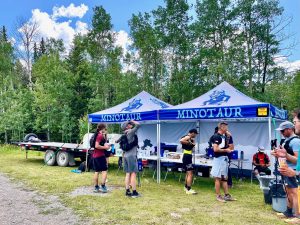
Aid station number three is an airy affair, lots of space, even for a dog that by now has had so much stimulation that he needs nothing to set him off. Poor guy, it’s been a long day for him too. More electrolytes, more chips, and a fill of water for a flask in which I put a Nuun tablet. According to the watch there is four and a half kilometers to go, and fifty seven minutes to do them to get sub nine. Easy.
With thirty three and a half kilometers on the watch I come across a small trailside sign reading “2km to finish”. This race was supposed to be over. I don’t want to walk it in, it’s still a race, so the tired jog continues. The trail runs alongside the highway for a bit, and then through the outskirts of Blairmore. A family is sitting outside their back gate, cheering me on. I pass three more racers on the last stretch. Finish in 8h54 and change, in the anonymity of the back of the middle of the pack. A metaphor for life perhaps.
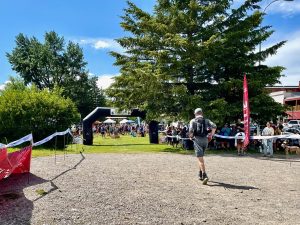
It is done. The beast has been slain. We get some smoothies at the Cafe Stones Throw right at closing time. Eat some tacos at the food truck. We need to get home, take care of the ailing old dog. A quick stop outside of town for a parking lot shower – my daughter pouring water over my head from a jug, a break at Chain Lakes for ice cream, mango-chocolate; at home nachos and a beer drank from the glass with the Minotaur logo.

Till we meet again, Minotaur… perhaps.
FD
